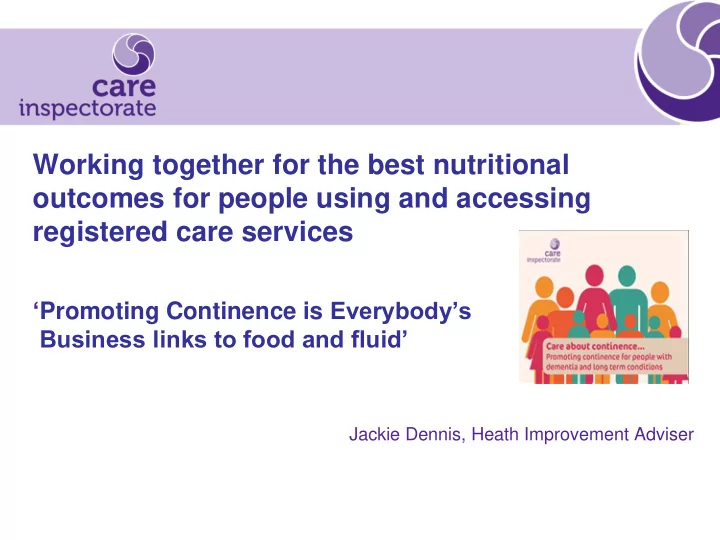

Working together for the best nutritional outcomes for people using and accessing registered care services ‘ Promoting Continence is Everybody’s Business links to food and fluid’ Jackie Dennis, Heath Improvement Adviser
Aim of the session: • Update of the changes at the CI within the Health Team • National statistics that link to nutrition • The resource – key messages • What’s next? – working together • Q&A
Line Management of Health & Well- being Improvement Team • Health Team Manager • 4.2 Advisers • 2 Consultants
Statistics - Summary at Dec 2014 Annual Returns data for Care Homes for Older People (CHOP) • 868 CHOP submitted a 2014 Annual return • 32,869 people living in these care homes • 18,403 service highlighted as on meds for constipation = 56% of all residents • 4,771 were using supplements = 14.5% • 2,938 were deemed faecal incontinent only = 9% • 11,272 were deemed incontinent of urine only = 34% • 14, 105 were deemed incontinent of both U&F = 43% • How many staff have received continence CPD - ? And - 1 in 5 residents in a recent study were suggested as being dehydrated
Complaint statistics 1 April 2014 to 31 March 15 • Received 4,436 complaints – increase of 19% • Formally registered 2,037 • 1,992 complaints were completed • 993 complaints were completed about CHOP • 562 were upheld The top five specific reasons for complaints being made • General health and welfare • Staff levels • Communication between staff and service users, relatives and carers • Staff other • Staff training and qualifications
Most common nutrient deficiencies in older people • Water • Vitamin C • Vitamin D • Iron/folic acid • Dietary fibre • Kcals
Hydration • 6-8 cups • 1500mls • 1600mls • 30 mls per kg • 25-35 mls per kg
Dietary Reference Values • DRV’s apply to healthy people. They do not take into account the effect on energy and nutrient needs imposed by some diseases/conditions. • Avoid deficiencies • Advice to promote health • For groups of people
Nutritional care in care homes: current position • challenges in maintaining optimum hydration • high proportion of residents on medication for constipation • Mealtime experience • generally seeing a downward trend in % residents with low BMI but some exceptions • growing trend for overweight and obesity • some residents still loosing weight even although on fortified diet and/or prescribed dietary supplements
Promoting Continence: The Resource This resource has 5 key messages Know me and what’s important in my life and do what’s best 1. for me 2. Know me and how I communicate 3. What do I need to stay continent, how you can help 4. Create an environment that supports me to be independent and promotes continence . Look for every opportunity to promote my continence – Be 5. creative Launched 5 June 2015
Working together – whole person Environmental Factors Links/access to local Health Evaluation Services Equipment Infection Prevention & Continence Resource Implications control Leadership/Staff Competence Fibre and Impact fluid intake on skin Assessment Tissue SU Nutrition Planning Viability Use of Supplements aperients Functional ability Mental Health & Capacity Palliative Care Medicines Consent Implementation SU Involvement
Next steps • How do we work together? • Bladder & Bowel Health promotion events in February 2016 • Care Home ‘cook book’… • Veggie cook book • Snacks for Older People • Local contacts • Sharing best practice
How can the Care Inspectorate help? • HUB > http://hub.careinspectorate.com > links to best practice/guidelines • New today on website • Health Guidance • Health care triggers >benchmark/self assess • Use inspection reports/complaint outcomes on web as a benchmark to improve quality of care • Use best practice to inform policies / procedures • Contact consultants/advisers
Thank You For Listening
Recommend
More recommend